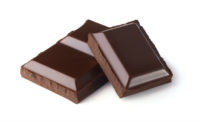
[Editor’s note: The following executive summary was gleaned from Packaged Facts’ “Chocolate in the U.S., September 2010 report. For additional information about the report, visit www.packagedfacts.com]
Last
year, U.S.
retail chocolate sales topped $17.3 billion, a new record. These sales mark a 2.8% increase over 2008,
but a percentage point lower than pre-recession 2007. Price increases by
chocolate manufacturers in response to higher commodity and transportation
costs played a key role in accounting for the higher sales total.
Product
premiumization and a rise in health claim were also factors.
And
while volume/quantity jumped 3.1%, those numbers did not stem from higher
manufacturer shipments, but rather as a result of a -10.3% drop in exports and
26.9% rise in imports.
This
chocolate sales growth differential between value and volume started six years
ago in 2003. Since then, the value of
chocolate sales has grown at a 2.5% compound annual growth rate (CAGR), while
the quantity sold increased at only a 0.4% CAGR.
These
growth rates characterize a mature industry with well-established
marketers. Market analysts suggest that
future market growth will shift to emerging markets in the Asia-Pacific region.
Everyday
chocolate sold in 2009 through food store, drug store chain and mass merchandiser
(FDM) distribution channels accounted for 70% of total chocolate sales,
followed by seasonal chocolate with 24%.
The remaining three product categories (novelty, gift box and
sugar-free) had a combined market share of 6%.
Over
the past six years (2004 to 2009), every day chocolate has gained a 3% market
share at the expense of gift boxed chocolates, while share growth in the other
three categories was flat.

Consumer interest in sugar-free products peaked in 2004, during the low-carb fad, and then plummeted -24% the following year. While sales in this category are still declining, the magnitude of these sales contractions is getting smaller. Sales growth in the gift box category is flat.
In contrast, 2009 total chocolate volume dropped -6.2%, with declines in almost every category. (The exception was seasonal with 0.7% growth.) In short, sales gains were achieved through price increases and product premiumization.
The value of U.S. per capita chocolate consumption in 2009 increased 1.9% to $56.27. Americans generally spend more for chocolate each year. But while per capita chocolate dollar sales have been increasing six of the past eight years since 2002, Americans are actually buying smaller amounts of chocolate.
Per capita chocolate consumption by quantity peaked at 12.6 pounds in 2005 and has since fallen -6.4% to 11.8 pounds in 2009.
Chocolate’s recession-resilience may be due to its “lipstick factor.” Economists have noted that lipstick sales tend to rise during economic recessions, as the relatively inexpensive purchase provides comfort and solace for female buyers.
Eating chocolate might have the same affect. When times get tough and household budgets turn frugal, spending a few dollars on a good bar of chocolate becomes a terrific way to leverage a piece of indulgence.
Packaged Facts forecasts that the U.S. chocolate market will increase an average 3% per annum through 2015, with sales topping $19 billion, up 10.4% from $17.3 billion in 2009. Below the surface, however, there will be sales currents that will favor some categories over others.



